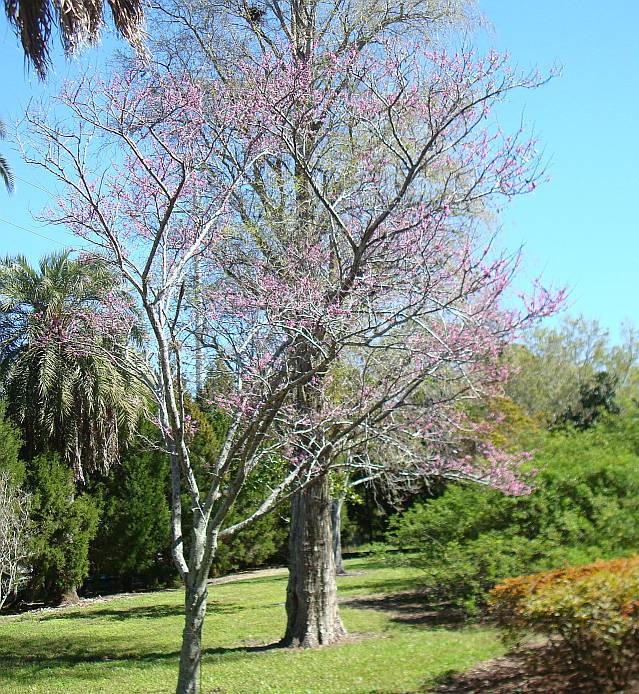A redbud tree puts on a spectacular show of fiery pink blooms in early spring (March to April) that most people are likely to remember always. The entire deciduous tree fills up with miniature clusters of bright purplish-pink flowers that extend out from smooth grey branches and even the trunk. The fading pea-like flowers in spring give way to heart-shaped, finely veined red-green leaves in the full sun of the summer and then there are brown pods that remain on the tree even after the leaves fall. These features along with the redbud’s compact size have made it one of the most popular small trees to brighten up residential gardens. Additionally, planting and taking care of redbud trees is rather easy.
Noteworthy Characteristics Of Redbud
The redbud tree is a member of the bean family that is native to the eastern United States but will grow in USDA planting zones 4 through 8 (we are zone 9 & 10). It can easily adapt to a wide range of growing conditions and temperatures ranging from -18° F in the winter to the 90°+ F Florida summers. The tree thrives in most types of soil but it grows best in moist, well-drained soil. It does not thrive in salty soil conditions though. It can handle different kinds of sun exposure from full sun to partial shade but redbud grows best in direct sun.
This is a moderately fast growing tree that depends on bees for pollination. When the leaves fall in autumn, the fruit pod remains on the tree till it matures and opens up to disperse the seeds through the wind. The tree attracts wildlife such as the deer who feed on its leaves and songbirds such as Carolina chickadee and the northern bobwhite that enjoy the seeds.
Where To Plant Redbud Trees
Redbuds are not large trees and will reach between 20 and 30 feet in height and 15 to 30 feet in width. It has several picturesque trunks divided close to the ground and the arched branches and the wide umbrella-like crown makes for an attractive canopy for spring bulbs. Redbud trees are grown in naturalized or woodland areas as understory trees and also as shrub border or specimen in small gardens along with other smaller flowering trees such as crabapples and serviceberries.
It is best to plant a Redbud tree late fall to early spring. Once you have narrowed down your planting site, you need to dig a hole, three times wider than the tree’s root. Place the tree in the hole straight and make sure that the root ball is even or slightly higher than the surrounding ground with the ground before filling the hole with native soil. Water thoroughly once you have finished planting the redbud tree.
How to Care for a Redbud Tree
Growing Redbud trees is simple enough with no elaborate maintenance rituals. Redbud trees are tolerant to moderate dry spells, but when they are planted in full sun, they need to be watered regularly. But while the tree is establishing, it is advisable not to saturate the soil with water.
You need to make a ring of about 3 inches of mulch around the base of the trees planted in the lawn. The wood chips or bark mulch helps to keep the soil cooler, moist and weed free. It also protects the trunk from lawn mowers and string trimmers.
You may want to fertilize your trees in spring with a wild slow release fertilizer and prune the dead branches and limbs in late fall in order to maintain the tree’s structural beauty and health.
Redbud trees have a short lifespan of about 25 years because of its susceptibility to canker, verticillium wilt, dieback, tree borers and root rot. Get in touch with experts at your local nursery for early identification and proper diagnosis before treating your tree for disease, fungal infection or insect infestation. You have to prune and remove affected areas and also be careful not to spread the fungi to other plants in your garden. You can purchase this lovely ornamental tree at Wilcox Nursery & Landscape.


